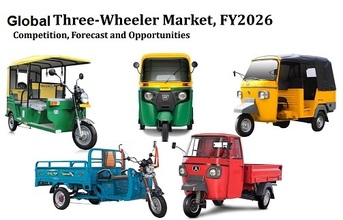
According to the TechSci Research report "Global Three-Wheeler Market By Vehicle Type (Passenger Carrier Vs. Load Carrier), By Fuel Type (Petrol/CNG, Diesel & Electric), By Region (Asia-Pacific, Africa, South America, Rest of the World), Competition Forecast & Opportunities, 2026", the global three-wheeler market is estimated to reach around a total of USD11.68 billion by 2026.
Growth in the global three-wheeler market can be attributed to the increasing number of micro, small & medium enterprises (MSME's) across the globe, improving road infrastructure and cheap fares of three-wheelers as compared to other forms of transportation to commute within the city. The increase in population of middle-income group, improving living standards of the people and growing tourism across the globe are booming the demand for three-wheelers across the globe. According to the International Tourism Highlights 2019 Edition report, published by the United Nations World Tourism Organization, the Asia and the Pacific region accounts for 25 per cent of global tourist arrivals. Majority of these tourists visited South-East Asian countries, particularly countries like India, China, Sri-Lanka, Indonesia, etc. Moreover, in these countries three-wheelers are the most favorable means of local transportation.
The reason for growing popularity of three-wheelers for commuting within the cities can be attributed to the fact that three-wheelers in these countries are present in abundance and provide easy accessibility and have cheap fares as compared to other means of transportation. Apart from the growing tourism, increasing popularity of electric-three wheelers in the world and continuously improving road infrastructure are also contributing to the growth of the Global Three-Wheelers Market. With growing technological advancements due to increasing awareness about the usage of
smartphone apps & web applications, a recent trend has been witnessed in the three-wheeler market of Asian countries. Cab companies in conjunction with radio taxis have also started providing online three-wheeler booking services to customers. Earlier, this booking was limited to four-wheeler cabs and taxis, but due to the wide presence of three-wheelers in these countries, companies have started giving customers an easy on-click booking of three-wheelers via smartphones and personal computing devices for traveling short distances within cities. As a result, the Global Three-Wheeler market has huge penetration of three-wheelers in Radio Taxi Market. Owing to increasing number of Micro, Small & Medium Enterprises (MSME's), growing demand for Electric Three-Wheelers, continuously improving road infrastructure, the Global Three-Wheeler Market is anticipated to grow with a CAGR of 5.22% in terms of units sold in the forecast years.
In 2020, three-wheelers sales declined in comparison to 2019 as countries around the world underwent strict lockdown in the second and third quarter of 2020 as a measure to counter the spread of the disease. The lockdown resulted in the temporary closing down of all factories, including three-wheeler manufacturing facilities, resulting in production loss of three-wheelers. Furthermore, the governments of most of the COVID-19 affected countries implemented social distancing norms that limited the number of workers working at any given point in the same facility. Such measures hampered the workflow of three-wheeler manufacturing facilities temporarily. As markets started to gradually open in 2020, the sales of three wheelers started to increase again, hence contributing to the recovery of the Global Three-Wheeler market recovery in the fiscal period 2021-2022.



























